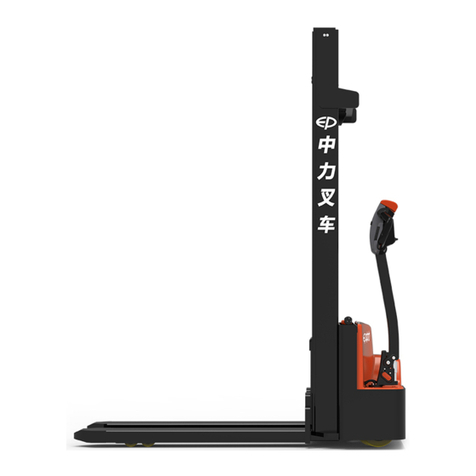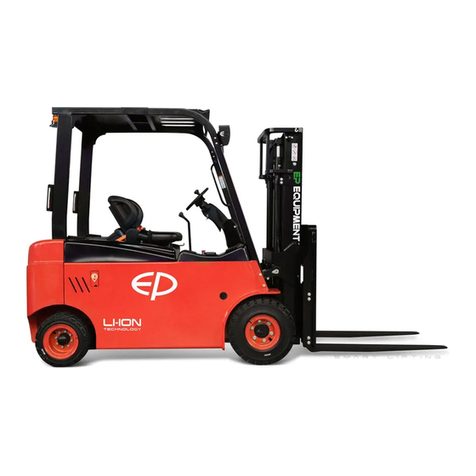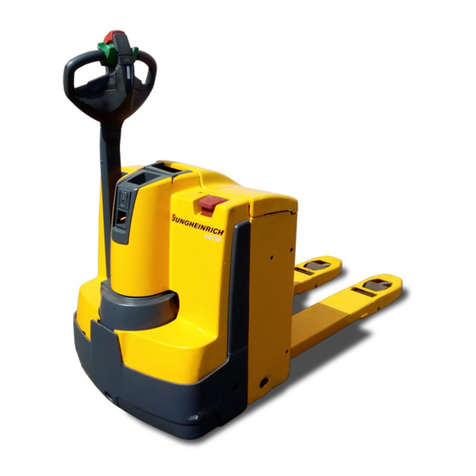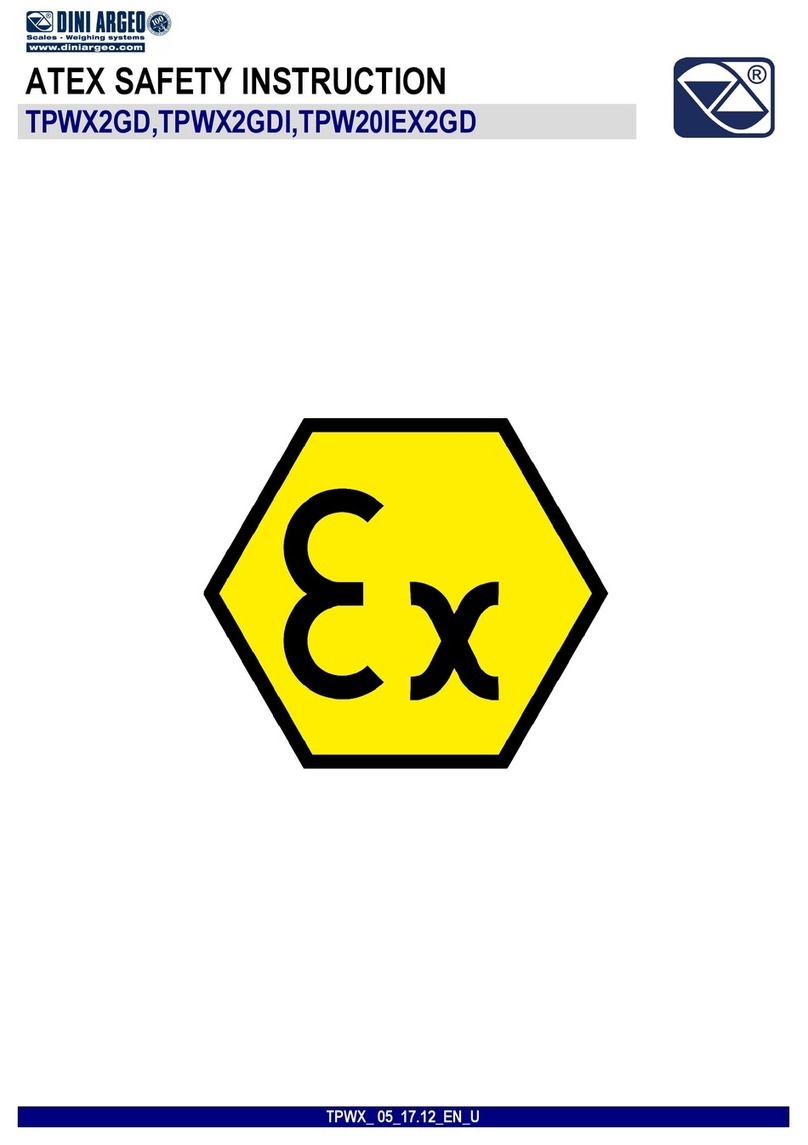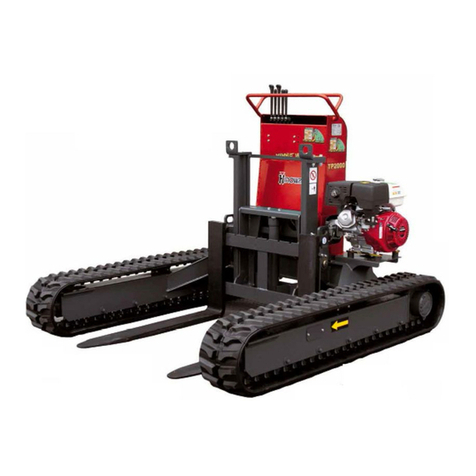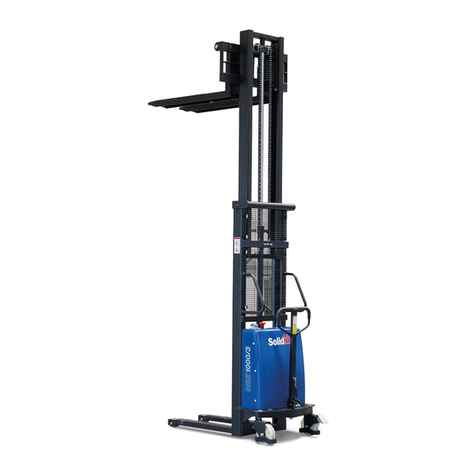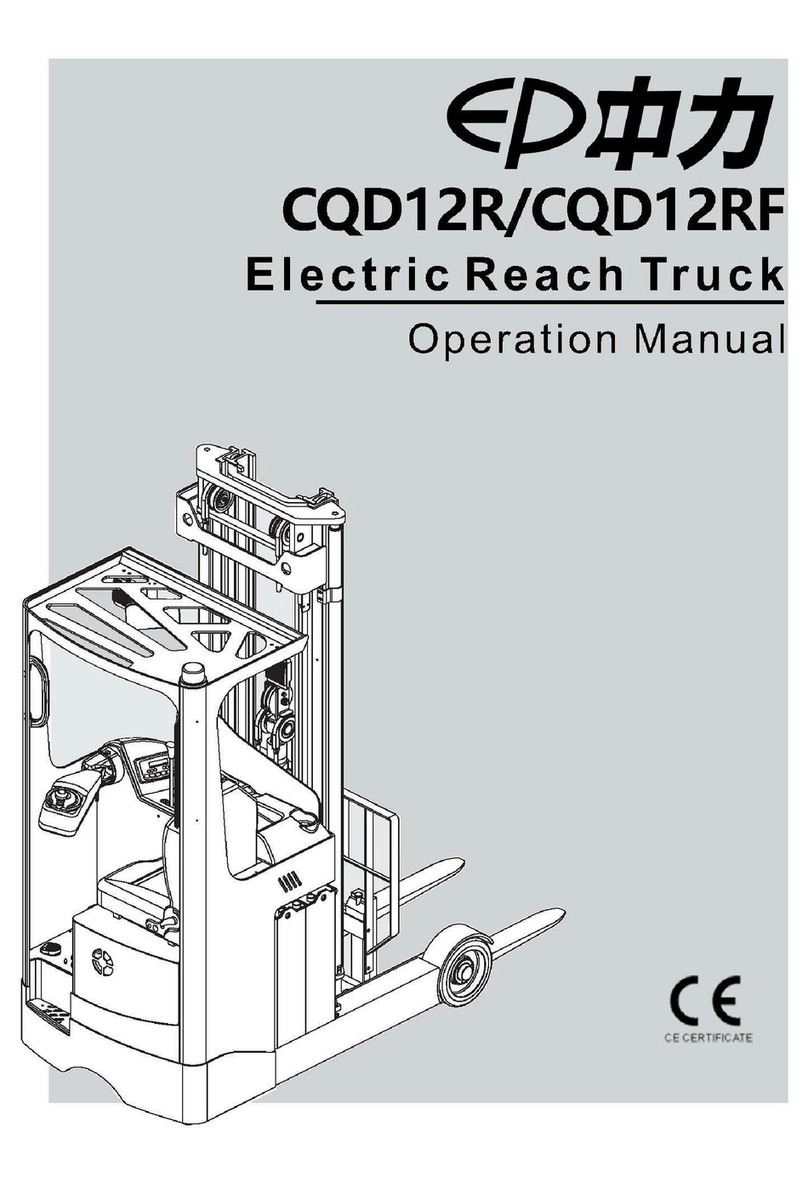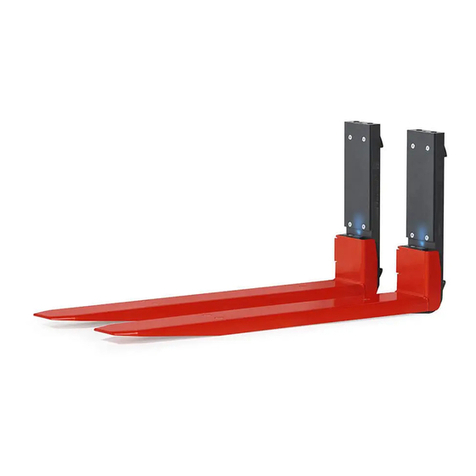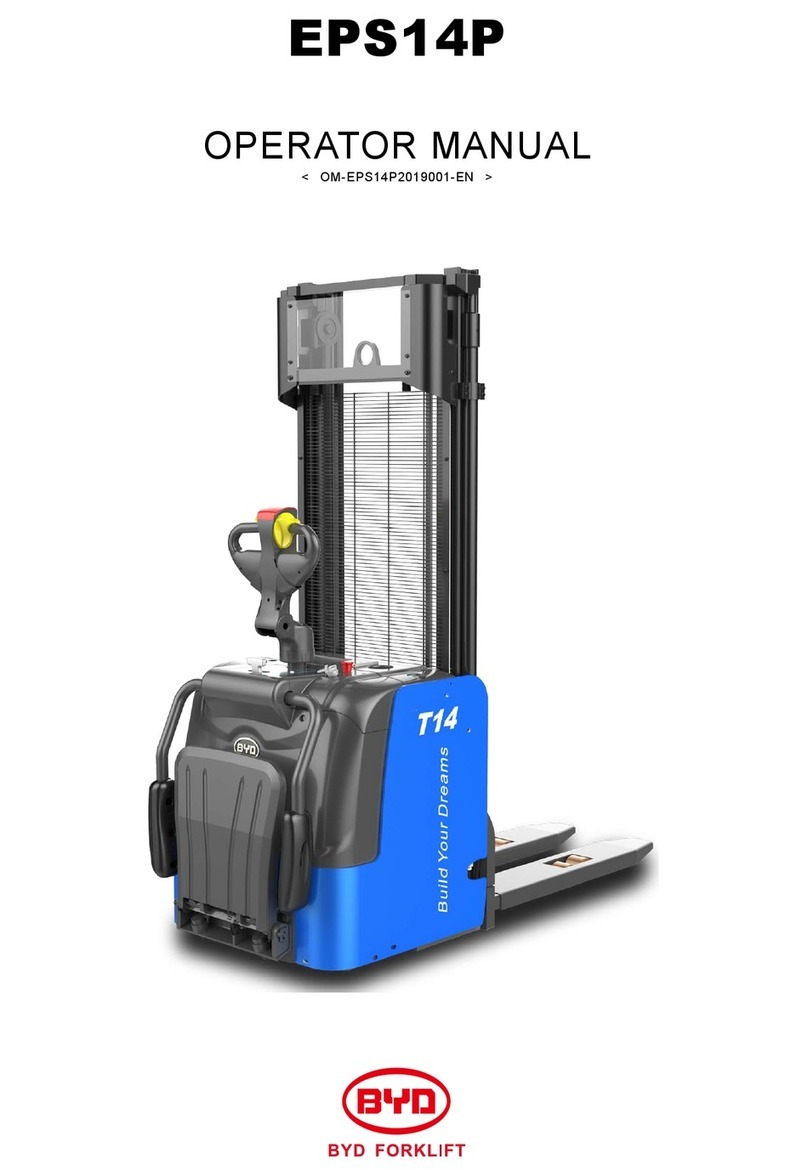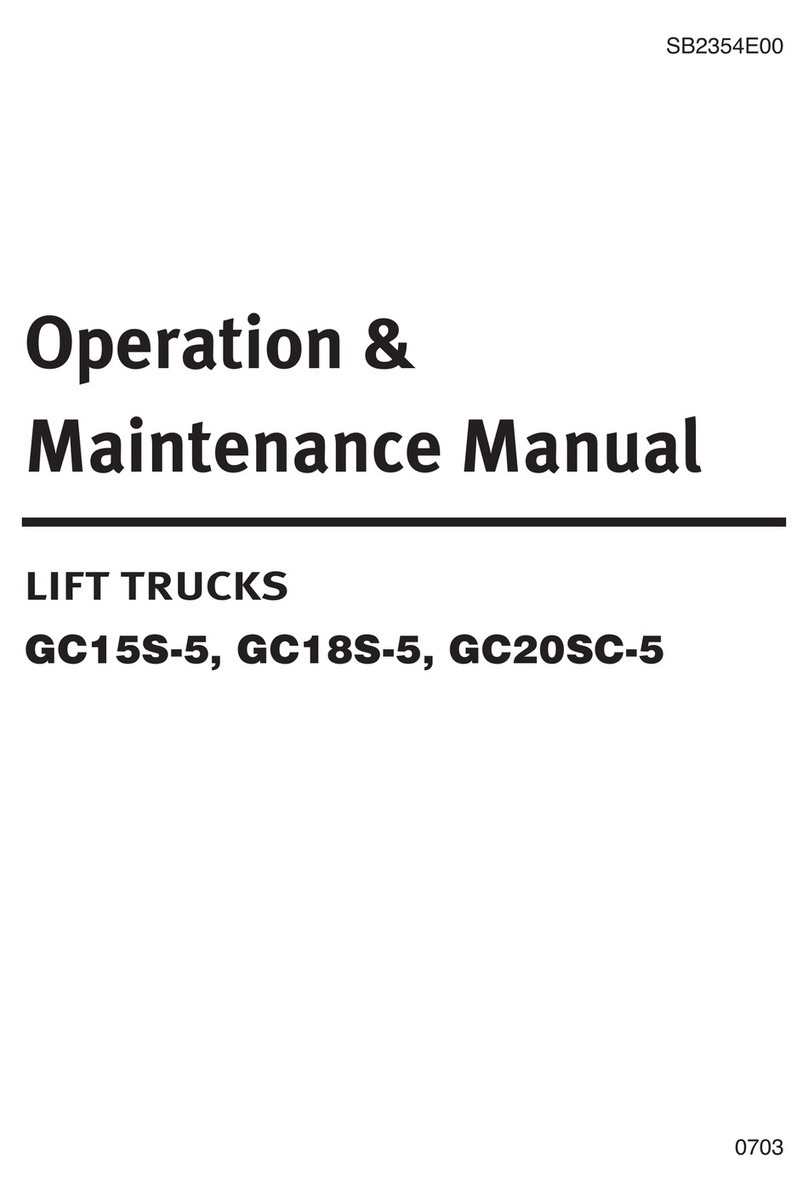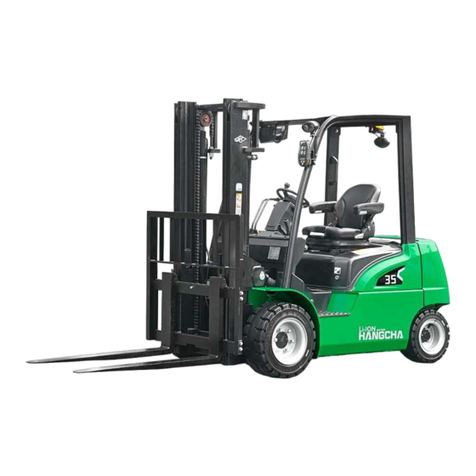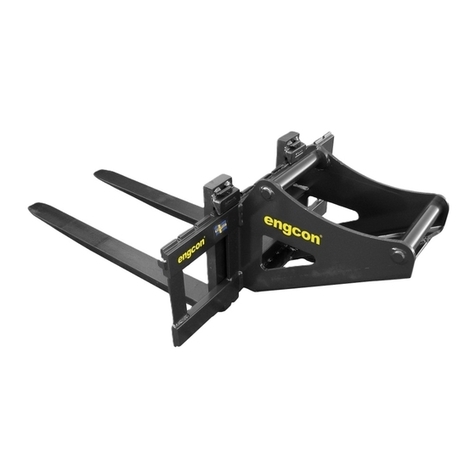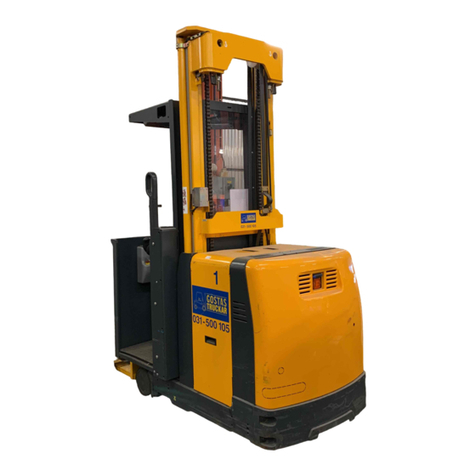EP Equipment EPT20-15ET User manual

Original Instruction
Operation Manual
EPT18-EHJ
EPT20-18EA
EPT20-ET
EPT20-15ET
EPT20-15ET2
EPT20-15EHJEPT20-15ETL
Part No.508000004646
V4 07/2020

EP EQUIPMENT CO.,LTD. is one of the world’s
leading companies manufacture, design
material handling equipment and provide related
service. With over 100,000 square metres plant
it produces over 100,000 trucks per year, and
provides professional, eective and optimized
material handling solutions worldwide, until now
it has developed three major kinds of business:
Material handling equipment: Focus
on electric forklift and warehouse
equipment
OEM parts: Global parts supply
Imow industry,online: One-stop
industrial products supply
Guided by our customer-oriented concept, EP
has developed service centers in more than
30 countries around the world, from which
customers are able to receive timely local
service. Moreover, 95% of warranty parts can be
shipped out within 24 hours after been ordered.
Through our online after-sales service system,
customers can process their warranty claims,
order spare parts and consult the operation
manuals, maintenance materials and spare
parts catalogs.
With business all over the world, EP has
thousands of employees and hundreds
of agents worldwide to provide our global
customers with prompt local service.
Based on the concept of sharing economy ,
EP also oer rental service for various logistics
equipment. Adhering to the idea “Making the
leasing of logistic equipment more simple”,
EP is devoted to providing customized one-
stop leasing solutions for our customers with
our high quality, reasonable price and prompt
rental service.
EP’s mission&vision is “ Let more people apply
the electrical material handling equipment to
relieve the intensity of labour” and “Let’s grow
together”.
•
•
•
Fig0000-00011OM
EP EQUIPMENT CO., LTD
Address: No.1 Xiaquan Village,
Lingfeng Street, Anji, Huzhou,
Zhejiang
Tel: + 86-0571-28023920
Website: www.ep-ep.com
Email: [email protected]

Thank you for buying our products.
The manual will show you the way of correctly using the truck as well as relevant preventive
maintenance and safety operation. The truck should be operated only by well-trained professionals
and by no means by non-working personnel. Operators are supposed to read through the manual
before actually operating the truck.
With the continuous upgradation and improvement of our company’s products, you may nd a
slight dierence existing between your carrier and some introductions in the manual.
All the information, specications and illustrations in the manual are eective in times of printing
and our company maintains the right to modify the specication (s) or design (s) of our products at
any time without any beforehand notication.
Means that failure to comply can cause risk to life and/or major damage to property.
Please strictly adhere to these safety instructions to avoid personal injury or major damage to
equipment.
Please pay attention to the important safety instructions.
Pay attention to Instruction.
DANGER
i
CAUTION
NOTE
WARNING
Explanations on the manual
Safety signs and corresponding esplations
Preface
Internet address and QR code of
Parts manual
By entering the address http://www.ep-
care.com in a web browser or by
scanning the QR code, Login after
registration, Select “Parts purchase"
function and input part number or model
name to nd the truck.
Note: After registration, please send email
to info@ ep-care.com to activate your
account

The lift truck is designed for transporting and stacking the loads stated in the nameplate.
In particular we refer to:
• the safety rules of your trade association.
• In accordance with the special provisions for driving on public roads specied by national
specications.
• Other local regulations.
The rules for the intended and approved use of industrial trucks must be followed under all
circumstances by the responsible persons, especially by the operator and service personnel.
The user, and not EP, is responsible for any danger arising from applications not authorised by the
manufacturer.
If you want to use the truck for applications not mentioned in this manual, please rst contact your
authorised dealer.
No changes, particularly no modications and additions, may be made to the truck without the
approval of the manufacturer.
• These trucks are electrical low-lift pallet trucks pallet trucks for EPT20-15ET2 / EPT20-ET/
EPT20-15ET / EPT20-18EA.
• EPT15-EHJ and EPT18-EHJ are semi-electrical hand pallect truck with electrically powered drive
wheels.
• These trucks consists of robust steel chassis and is driving on a traction wheel and 2 load
wheels. Caster wheels(for EPT20-18EA,EPT20-ET) provide for good stability even with high
loads.
• These trucks will be stopped by a regenerative service brake and hold by an automatic
electromagnetic parking brake in it’s parking position.
• The load is lifted by a hydraulic cylinder that activates a lifting shaft that transmits the lifting
movement by a push-rod to the load wheels.
• The control handle is used for smooth steering and control of drive speed, lifting and lowering,
braking and the horn without changing the position of the hand. The long tiller shaft allows
eortless steering and a safe distance to the truck. A gas spring returns the control handle
always into a vertical position that activates the brake automatically.
• An emergency reverse switch on the control head protects the operator from being squeezed by
the truck in conned spaces.
• An electronic controller operates all electric functions and guaranties safety.
• A key switch secures the truck from unauthorized use.
• The ergonomic design of the truck guaranties safe and easy operation.
Intended use
Technical description

In the manual, “equipment user” refers to any natural person or legal person directly using or
appointing or authorizing others to use the carrier. In such special situations as renting or sales,
the “equipment user” represents the interested parties supposed to bear operation obligations
as specied by the contractual terms concluded between equipment owner and corresponding
users. Equipment users must ensure the use of the carrier only for purposes specied and timely
eliminate all the dangers that may threaten the life and health of the users themselves or any other
third party, in addition to which they must also strictly abide by accident prevention provisions,
other safety technology provisions and equipment operation, maintenance and repair guidelines,
and ensure that all the operators seriously read and completely understand the contents of the
operation instruction.
Should any violation of the operation instruction occur, the quality guarantee of our company will be
invalid automatically, and our company will assume none of the responsibilities for losses resulting
from any nonstandard operation of the equipment implemented by any client, equipment user or
any third party without the authorization of the client service department of our company.
Obligations and responsibilities of equipment user
Modication
Unauthorized modication to the truck can result in injury or death.
Can not remove, disable or modify any safeguards or other safety devices.
Exception:Only in the event that the truck manufacturer is no longer in business and there is no
successor in the interest to the business, may the user arrange for a modication or alteration to a
powered industrial truck, provided, however, that the user
a) arranges for the modication or alteration to be designed, tested and
implemented by an engineer(s) expert in industrial trucks and their safety.
b)maintains a permanent record of the design, test(s) and implementation of the modication or
alteration.
c) approves and makes appropriate changes to the capacity plate(s), decals, tags and operation
manual.
d) axes a permanent and readily visible label to the truck stating the manner in which the truck
has been modied or altered, together with the date of the modication or alteration and the name
and address of the organization that accomplished those tasks.
Wind forces can aect the stability of a truck when lfting, lowering and transporting loads with large
surface areas .
Light loads must be especially secured when they are subjected to wind forces. This will prevent
the load from sliding or falling.
Stop the truck in both cases.
Wind loads

Declaration
EP EQUIPMENT CO., LTD.
Address: No.1 Xiaquan Village, Lingfeng Street, Anji, Huzhou, Zhejiang
We declare that the machine
Industrial truck: according to this operation manual
Type: according to this operation manual
complies with the most recent version of Machinery Directive 2006/42/EC.
Personnel authorised to compile the technical documents:
See EC/EU Declaration of Conformity
EP EQUIPMENT CO., LTD.
EC/EU Declaration of Conformity
The manufacturer declares that this industrial truck complies with the EC Machinery Directive
and the provisions of other applicable EC/EU directives eective at the time of sale. This can be
veried by means of the EC/EU Declaration of Conformity and the relevant certication label on the
nameplate.
The industrial truck is supplied with the EC/EU Declaration of Conformity document. This
declaration proves that this truck complies with the requirements of the EC Machinery Directive.
Unauthorised modication or additional installation of equipment to the structure of the industrial
truck may aect its safety, and will therefore invalidate the EC/EU Declaration of Conformity.
The EC/EU Declaration of Conformity must be carefully stored and made available to be presented
to the relevant authorities when necessary. If this industrial truck is sold, this declaration document
must be handed over to the new owner.
Legal requirements for marketing

Table of contents
Pg.
A Identication points and data plates...................................................................................... A1
B Operation .............................................................................................................................. B1
2.1Utilization safety specication.............................................................................................. B1
2.1.1 EN standards ........................................................................................................................B2
2.1.2 Conditions for application .....................................................................................................B3
2.1.3 Stability..................................................................................................................................B3
2.2 Display and manipulation ................................................................................................... B4
2.2.1 Control handle......................................................................................................................B4
2.2.2 Key switch............................................................................................................................B5
2.2.3 Display instrument ...............................................................................................................B5
2.3 Truck use and operation .......................................................................................................B7
2.3.1 Preparation for use ...............................................................................................................B7
2.3.2 Comissioning ........................................................................................................................B8
2.3.3 Truck starting.........................................................................................................................B9.5
2.3.4 Runing, swerving and braking ..............................................................................................B11.
2.3.5 Good picking .........................................................................................................................B15.
2.3.6 Parking the truck securely ....................................................................................................B17
2.3.7 Drive directions .....................................................................................................................B18.10
2.3.8 Loading .................................................................................................................................B18
2.3.9 Using the truck on a slope ....................................................................................................B18
2.3.10 Operating the truck without its own drive system ..............................................................B21
2.3.11 Transporting the truck.........................................................................................................B22
2.3.12 Control handle installation ..................................................................................................B23
C Battery use and maintenance ............................................................................................... C1
3.1 Safety and warning............................................................................................................. C1
3.1.1 Safety regulations for handling acid batteries ................................................................. C12.1
3.2 Battery charging ................................................................................................................. C2
3.2.1 Precautions...................................................................................................................... C2
3.2.2 Charging the battery ............................................................................................................C2
3.2.3 Battery charging LED light ..................................................................................................C2
3.2.4 Battery type & dimensions&Charging time...................................................................... C4
3.3 Battery removal and installation ......................................................................................... C5
D Maintenance ......................................................................................................................... D2
4.1 Truck maintenance ............................................................................................................. D2
4.2 Maintenance table .............................................................................................................. D2
E Technical data ....................................................................................................................... E1

REV. 07/2020
1A
Identication points and data plates
A
Have the nameplates of a truck xed its main body and alarming and funciton labels pasted on
its outer cover or frame.
Should any nameplate or labels lose or be damaged, please conduct replacement immediately
or contact with the sales department or corresponding agent of our company when necessary.
Such truck-related information as product model, serial number, manufacturing date, rated
load lifting capacity, lifting height, load centre distance and dead weight are all shown in the
nameplates.
Nameplate
Instructions label
Anti-pinch label Do not rest on the pallet label
Charging Light indicator Key switch

REV. 07/2020 2A
Emergency stop switch Emergency stop switch
Emergency stop switch
EPT20-15ET2EPT20-15ET
EPT15-EHJ EPT18-EHJ
Operator notice:“lift/lower”
Operator notice:“on/o”
EPT15-EHJ/EPT18-EHJ

REV. 07/2020
3A
Nameplate
Item Description
1 PRODUCT NAME
2MODEL TYPE
3 SERIAL NO.
4 MANUFACTURE DATE
5 LIFT HEIGHT
6 UNLADEN MASS
7UNLADEN MASS WITHOUT
BATTERY
8 BATTERY VOLTAGE
9 RATED DRIVE POWER
10 MAX BATTERY WEIGHT
11 MIN BATTERY WEIGHT
12 RATED CAPACITY
13 LOAD CENTER
Fig0000-00015OM
Hoisting
Remove the load before hoisting the pallet truck.
Disconnect the power supply.
Attach slings in the positions identied by the hook symbol.
Ax the crane lifting gear at the attachment points(1).(for EPT15-EHJ/EPT18-EHJ)
Personnel must not stand below or near the truck when the pallet truck is being lifted.
DANGER
Unscrew two screws (4) and two screws (10), then remove the upper cover(see the below
draft). Ax the crane lifting gear at the attachment points(1).(for EPT20-18EA)
1
2
3
4
5
6
7
8
9
10
11
12
13

REV. 07/2020 4A
1
EPT15-EHJ/EPT18-EHJ EPT20-15ET2
EPT20-15ET EPT20-ET
Fig1116-00044OM
Fig1115-00045OM
Fig1114-00046OMFig1122-00047OM
EPT20-18EA Fig1118-00043OM
1

REV. 07/2020
1
B
2.1Utilization safety specication
Operation
B
Applicable environment
temperature: 5 °C - 40 °C
Don’t use the truck in
rainwater.
Don’t use the truck in non-
position.
Avoid the use of the truck by non-
working personnel.
Don’t ride on the truck.
Don’t carry or lift people by the
truck.
Don’t use the truck on slippery
road surfaces.
(such as road surfaces with oil
stain or residual snow or those
frozen ones )
Don’t carry goods on steep
slope to prevent goods
from sliding o.
Conditions of operation road surface: the truck should run on solid, at, level and paved road
surfaces (including both running and lifting)
i
NOTE
i
NOTE
Fig0000-00120OM
Fig0000-00121OM
Improper use
Industrial trucks must be specially equipped and approved for continuous use in environments
with temperatures below 5 °C or in cold stores respectively with extreme temperatures or
humidity changes.

REV. 07/2020 2B
Don’t place any part of
your body in any moving
part of the truck to avoid
being clamped.
Don’t leave the truck before
it is parked as regulated.
Don’t use the truck when any
non-working personnel is in the
dangerous area.
Don’t be distracted when using the
truck.
Don’t be distracted when using the
truck.
2.1.1 EN standards
Continuous sound level: 74 dB(A)
according to EN 12053 as stipulated in ISO 4871
The continuous sound level is a value averaged according to standard regulations, taking the
sound pressure level into account when driving, lifting and idling. The sound pressure level is
measured at the ear.
Vibrations to which the hands and arms are exposed
The following value is valid for all truck models:
• āw< 2.5 m/s2
It is mandatory to specify the hand-arm vibrations, even where the values do not
indicate any danger, as in this case.
The value expressed above can be used to compare forklift trucks of the same category. It cannot
be used to determine the operator's daily exposure to vibrations during real operation of the
truck; these vibrations depend on the conditions of use (oor conditions, method of use etc.) and
therefore daily exposure must be calculated using data from
the place of use.
Electromagnetic compatibility (EMC)
The manufacturer conrms compliance with the limit values for electromagnetic emission and
interference immunity as well as testing of static electricity discharge according to EN 12895 and
the references to other standards contained therein.
Electrical or electronic components and their arrangement may only be modied after written
approval by the manufacturer has been obtained.
Fig1115-00122OM

REV. 07/2020
3
B
2.1.2 Conditions for application
Working condition requirements:
• The truck's maximum operation altitude is up to 2000m.
• Trucks can only be operated in adequately illuminated working areas to avoid injuries. In case
of insucient light, an additional lighting equipment is needed to ensure that the driver can see
properly.
• If you must travel on an incline, the gradients should be below A% at full load, or below
B%without a load.(For the value of A and B, refer to the Gradability in technical data)
2.1.3 Stability
Stability is guaranteed if your truck is used properly in accordance with its intended
purpose. Common reasons for a loss of truck stability include:
• Emergency stops or sharp turns
• Driving with a raised load or a load handling device
• Turning the vehicle around on or driving across a slope
• Driving up or down a slope with the load pointing downhill
• Driving with a wide load
• Carrying a swinging load
• Driving near the edge of a ramp or up steps
• Tilting the mast forward while carrying araised load
• Driving on uneven surfaces
• Overloading the truck
• Carrying bulky loads in strong winds
• When carrying liquid, its centre of mass inside the container may shift due to inertial force (such
as when pulling away, braking or turning)
Wind loads
Wind forces can aect the stability of a truck when lfting, lowering and transporting loads with large
surface areas .
Light loads must be especially secured when they are subjected to wind forces. This will prevent
the load from sliding or falling. Stop the truck in both cases.

REV. 07/2020 4B
2.2.1 Control handle
2.2 Display and manipulation
EPT20-15ET2 / EPT20-ET/
EPT20-15ET / EPT20-18EA EPT20-15EHJ / EPT18-EHJ
15 Drive forward button travel forward direction (see page B11)
16 Drive backward button travel backward direction (see page B11)
17 Lowering button Lower forks
18 Ling button Lift forks
19 Drive switch Controls travel direction and speed (see page B11)
20 Horn button Send out sound warning signals
21 Emergency reverse button Through touching the button, truck drives away from
operator.
Fig1115-00005OM Fig1122-00006OM

REV. 07/2020
5
B
2.2.2 Key switch
1.Key switch A
Connect and interrupt control current.
• When the key rotates to gear “OFF”,
the control current of the truck will be
interrupted;
• When the key rotates to gear “ON”,
the control current of the truck will be
connected.
2.2.3 Display instrument
(EPT20-15ET /EPT20-18EA)
1
with hour meter Without hour meter
with hour meter without hour meter
Battery discharge indicator
The LCD display (1) show the
operating hours.
LCD (2) displays the residual electric
charge of the battery;
1.2.3
(EPT20-15ET2/ EPT20-ET)
LCD (1) displays the residual electric
charge of the battery;
LCD (2) displays the total operation time
of the truck;
LCD (3) is a fault indicating light.
DISPLAY DESCRIPTION
Continuous red Normal
Flashing Truck failure.
Refer to relevant descriptions in
“discharge indicator and hour meter” for
the display functions of LCD (1).
Fig0000-00070OM
Fig1115-00006OM
Fig1116-00006OM

REV. 07/2020 6B
The LCD display (2) show battery residual capacity.
When the truck has been released via the key switch, the battery charge status is displayed.
The colour of the LCD (2) represent the following conditions:
Component LCD colour residual capacity
Standard battery residual capacity
Green 70-100%
Orange 30-60%
Flashing Red 0-20%
If residual battery capacity is below 30%, One ashing Red segments.
If residual battery capacity is below 20%, Two ashing Red segments. The battery must be
charged.
EPT20-15EHJ / EPT18-EHJ
• When the truck starts up, the battery
discharge status is shown via the the
battery discharge indicator.
• If the battery is fully charged, each LCD on
the battery discharge indicator is lit red.
• If the last three LCDS are lit, this indicates
that 70% of the battery capacity has been
used and the reserves are being utilised.
• If the last two LCDs are lit,this indicates that
80% ofthe battery capacity has been used.
The battery must be charged.
Fig1122-00011OM
Operating hours display(1)
Display range between 0.0 and 99,999.0 hours. Travel and lifting are logged. This is a backlit
display.
Power up test on power up the display shows:
• the operating hours.
• the charge status.

REV. 07/2020
7
B
2.3 Truck use and operation
2.3.1 Preparation for use
The following are inspection and preparation operations that must be implemented before the
truck is put into daily use.
Daily Check Items O.K.(√) Remark
Check for Fluid Leakage
Check operation switch, display equipment
and component functions.
Check horn.
Check forward and reverse driving control
functions.
Check the function of the service braking,
reverse braking, regenerative braking.
Check lifting and lowering control functions.
Check emergency safety reverser function.
Check the battery installation, making
sure not to damage the battery cables.
Check the function of the steering system
Check the battery charging connector.
Check the drive wheels and rollers for wear
and damage.
Check the hydraulic functions.
Check brake function of electromagnetic
brakes.
Check whether optional functions are
operating normally.
WARNING
Table 1: Table of Daily Inspections by Operators is only a sample table for the daily inspections of
operators, and it can be adjusted according to specic requirements.
The truck should be regularly maintained by qualied maintenance engineers or technicians
that have passed the training of and also been authorized by the manufacturer.
WARNING

REV. 07/2020 8B
The truck must only be operated on battery current!
To prepare the truck for operation after delivery or transportation, the following operations must be
performed:
• Check the equipment for completeness.
• If necessary, install the battery. Make sure that the battery cable is not damaged.
• Fully charge the battery.
• Check for Fluid Leakage.
• Check the brake function.
• Check the lifting and lowering function.
• Check the driving function.
• Check the steering function.
The truck can now be started, see 2.3.3
2.3.2 Comissioning
WARNING
Wheel attening
If the truck has been parked for a long period, the wheel surfaces may tend to atten.
This attening has a negative eect on the safety and stability of the truck.
Once the truck has covered a certain distance, the attening will disappear.
If the truck is delivered in multiple parts, setup and commissioning must only be performed by
trained, authorised personnel.
i
NOTE
These trucks must only be operated with a lead-Acid batteries.

REV. 07/2020
9
B
2.3.3 Truck starting
1. Release the emergency stop switch. (Insert the emergency disconnect for EPT15-EHJ)
EPT-18EA
EPT20-15ET2
EPT20-15ET
EPT-15EHJ
EPT20-ET
EPT-18EHJ
Fig1115-00007OM Fig1118-00008OM
Fig1114-00009OM
Fig1122-00010OM
Fig1116-00011OM
Other manuals for EPT20-15ET
2
This manual suits for next models
6
Table of contents
Other EP Equipment Forklift manuals
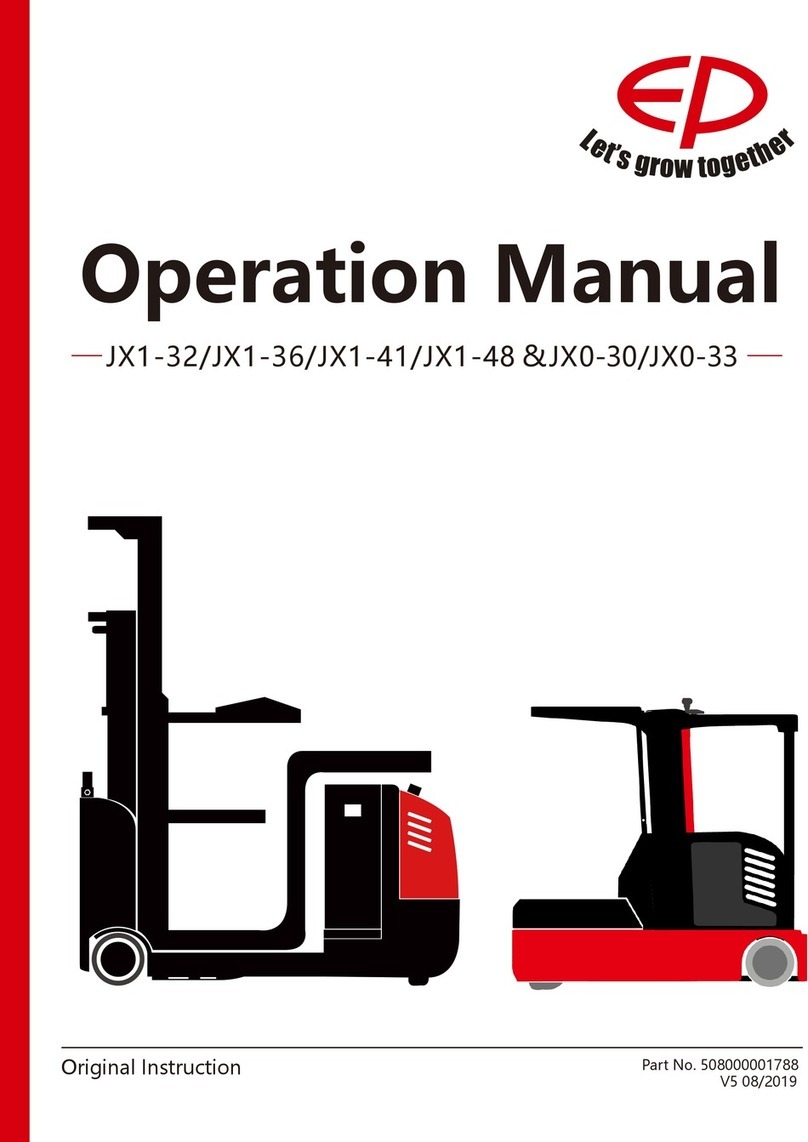
EP Equipment
EP Equipment JX1-32 User manual
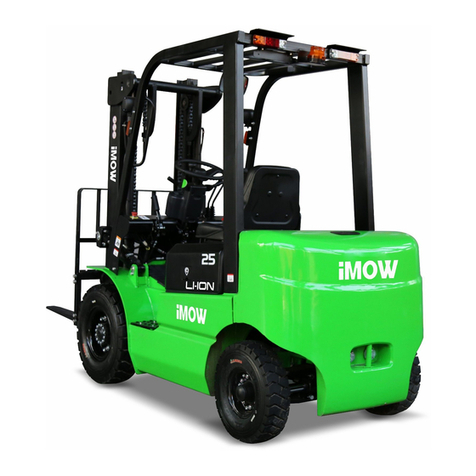
EP Equipment
EP Equipment IMOW ICE251 User manual
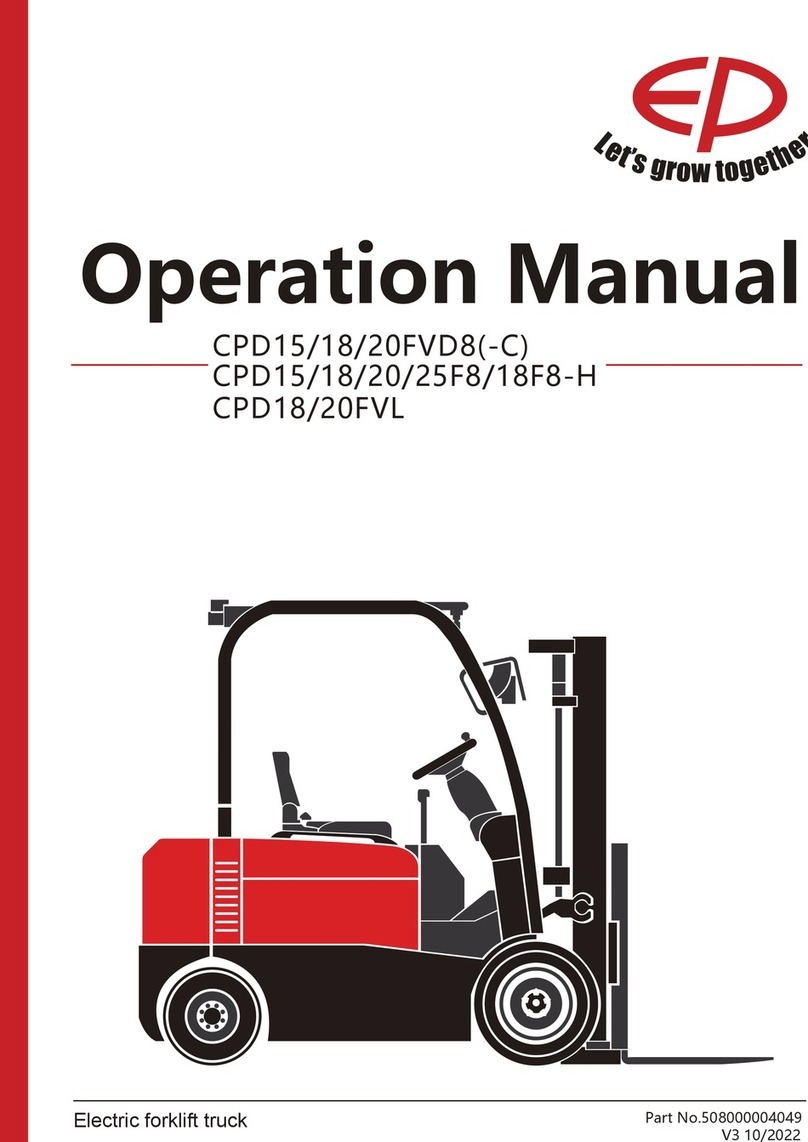
EP Equipment
EP Equipment CPD15/18/20FVD8(-C) User manual

EP Equipment
EP Equipment EPT20-15ET User manual
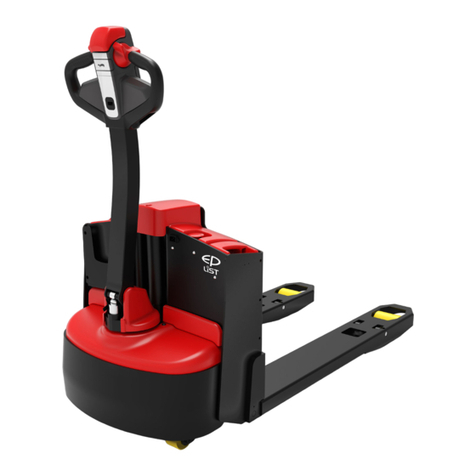
EP Equipment
EP Equipment EPL151 User manual
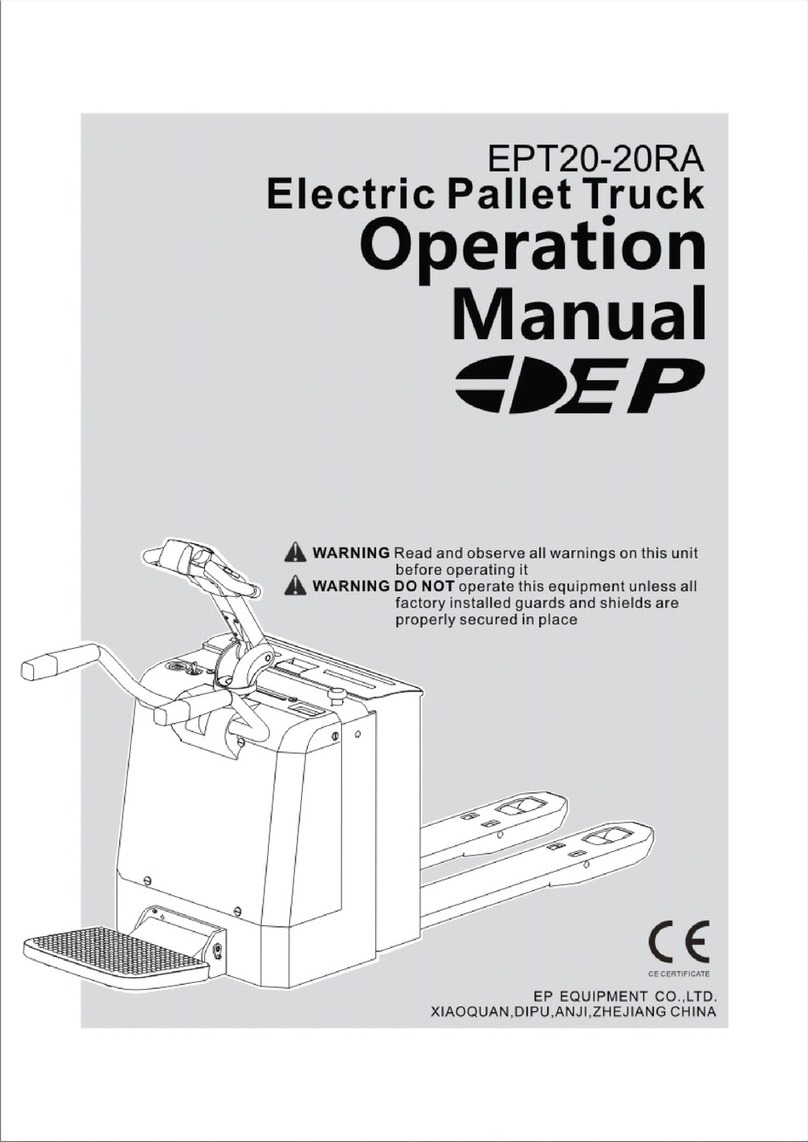
EP Equipment
EP Equipment EPT20-20RA User manual

EP Equipment
EP Equipment JX0-30 User manual

EP Equipment
EP Equipment EPL1531 User manual

EP Equipment
EP Equipment EPL153 User manual
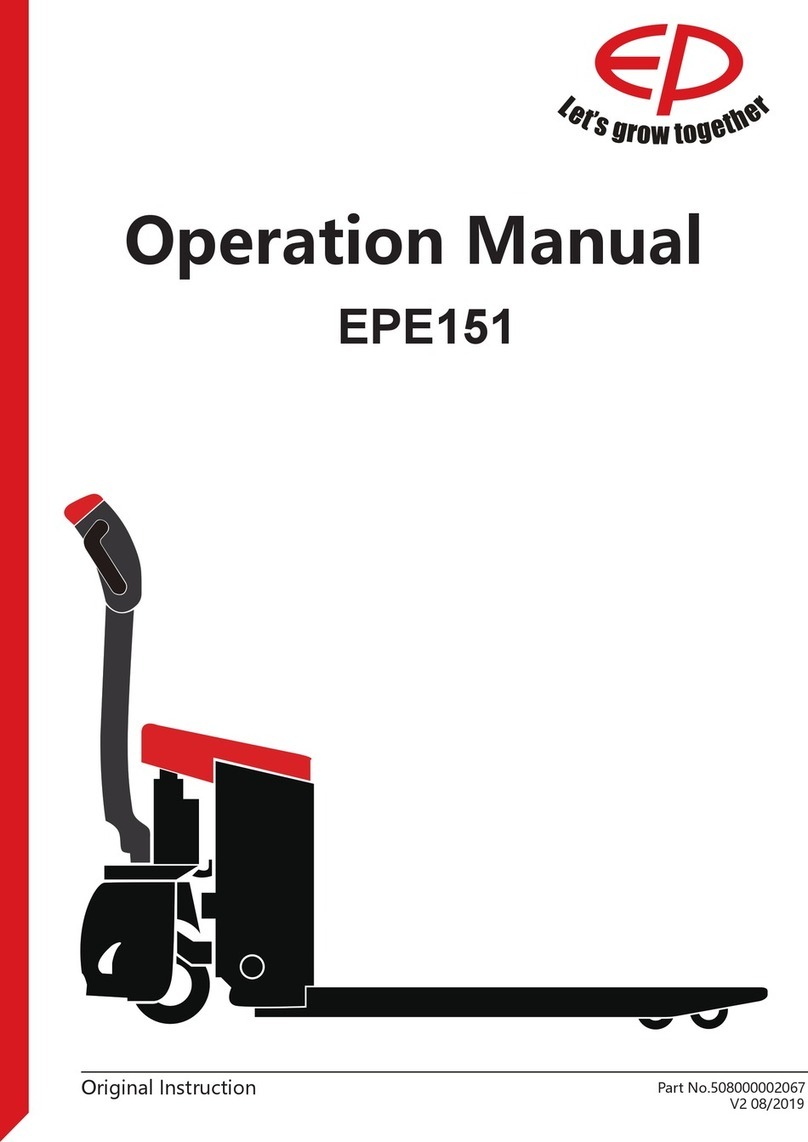
EP Equipment
EP Equipment EPE151 User manual
